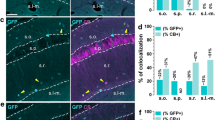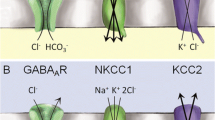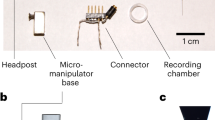Abstract
Since their initial discovery in 1997, Homer/Vesl proteins have become increasingly investigated as putative regulators of receptor and ion-channel function in the central nervous system. Within a relatively brief period, numerous research reports have described manifold effects of Homer proteins, including the modulation of the trafficking of type I metabotropic glutamate receptors (mGluRs), axonal pathfinding, mGluR coupling to calcium and potassium channels, agonist-independent mGluR activity, ryanodine receptor regulation, locomotor activity, and behavioral plasticity. This review summarizes our current knowledge on the induction, expression, and structure of the various forms of Homer proteins, as well as their roles in neuronal function. In addition, we provide an outlook on novel developments with regard to the involvement of Homer-1a in hippocampal synaptic function.
Similar content being viewed by others
References
Shiraishi Y., Mizutani A., Bito H., Fujisawa K., Narumiya S., Mikoshiba K., et al. (1999) Cupidin, an isoform of Homer/Vesl, interacts with the actin cytoskeleton and activated Rho family small GTPases and is expressed in developing mouse cerebellar granule cells. J. Neurosci. 19, 8389–8400.
Kato A., Fukuda T., Fukazawa Y., Isojima Y., Fujitani K., et al. (2001) Phorbol esters promote postsynaptic accumulation of Vesl-1S/Homer-1a protein. Eur. J. Neurosci. 13, 1292–1302.
Sala C., Piëch V., Wilson N.R., Passafaro M., Liu G., and Sheng M. (2001) Regulation of dendritic spine morphology and synaptic function by Shank and Homer. Neuron 31, 115–130.
Usui S., Konno D., Hori K., Maruoka H., Okabe S., Fujikado T., et al. (2003) Synaptic targeting of PSD-Zip45 (Homer 1c) and its involvement in the synaptic accumulation of F-actin. J. Biol. Chem. 278, 10,619–10,628.
Kato A., Ozawa F., Saitoh Y., Fukazawa Y., Sugiyama H., and Inokuchi K. (1998) Novel members of the Vesl/Homer family of PDZ proteins that bind metabotropic glutamate receptors. J. Biol. Chem. 273, 23,969–23,975.
Xiao B., Tu J.C., Petralia R.S., Yuan J.P., Doan A., Breder C.D., et al. (1998) Homer regulates the association of group 1 metabotropic glutamate receptors with multivalent complexes of Homer-related, synaptic proteins. Neuron 21, 707–716.
Diagana T.T., Thomas U., Prokopenko S.N., Xiao B., Worley P.F., and Thomas J.B. (2002) Mutation of Drosophila homer disrupts control of locomotor activity and behavioral plasticity. J. Neurosci. 22, 428–436.
Brakeman P.R., Lanahan A.A., O’Brien R., Roche K., Barnes C.A., Huganir R.L., et al. (1997) Homer: a protein that selectively binds metabotropic glutamate receptors. Nature 386, 284–288.
Kato A., Ozawa F., Saitoh Y., Hirai K., and Inokuchi K. (1997) vesl, a gene encoding VASP/Ena family related protein, is upregulated during seizure, long-term potentiation and synaptogenesis. FEBS Lett. 412, 183–189.
Berke J.D., Paletzki R.F., Aronson G.J., Hyman S.E., and Gerfen C.R. (1998) A complex program of striatal gene expression induced by dopaminergic stimulation. J. Neurosci. 18, 5301–5310.
Bottai D., Guzowski J.F., Schwarz M.K., Kang S.H., Xiao B., Lanahan A., et al. (2002) Synaptic activity-induced conversion of intronic to exonic sequence in Homer 1 immediate early gene expression. J. Neurosci. 22, 167–175.
Sun J., Tadokoro S., Imanaka T., Murakami S.D., Nakamura M., Kashiwada K., et al. (1998) Isolation of PSD-Zip45, a novel Homer/ves1 family protein containing leucine zipper motifs, from rat brain. FEBS Lett. 437, 304–308.
Soloviev M.M., Ciruela F., Chan W.-Y., and McIlhinney R.A.J. (2000) Mouse brain and muscle tissues constitutively express high levels of Homer proteins. Eur. J. Biochem. 267, 634–639.
Kaja S., Yang S.-H., Wei J., Fujitani K., Liu R., Brun-Zinkernagel A.-M., et al. (2003) Estrogen protects the inner retina from apoptosis and ischemia-induced loss of Vesl-1L/Homer 1c immunoreactive synaptic connections. Invest. Ophthalmol. Vis. Sci. 44, 3155–3162.
Sandonà D., Tibaldo E., and Volpe P. (2000) Evidence for the presence of two Homer 1 transcripts in skeletal and cardiac muscles. Biochem. Biophys. Res. Commun. 279, 348–353.
Fanning A.S. and Anderson J.M. (1998) PDZ domains and the formation of protein networks at the plasma membrane. Curr. Top. Microbiol. Immunol. 228, 209–233.
Hata Y., Nakanishi H., and Takai Y. (1998) Synaptic PDZ domain-containing proteins. Neurosci. Res. 32, 1–7.
Gertler F.B., Niebuhr K., Reinhard M., Wehland J., and Soriano P. (1996) Mena, a relative of VASP and Drosophila Enabled, is implicated in the control of microfilament dynamics. Cell 87, 227–239.
Haffner C., Jarchau T., Reinhard M., Hoppe J., Lohmann S.M., and Walter U. (1995) Molecular cloning, structural analysis and functional expression of the proline-rich focal adhesion and microfilament-associated protein VASP. EMBO J. 14, 19–27.
Reinhard M., Halbrugge M., Scheer U., Wiegand C., Jockusch B.M., and Walter U. (1992) The 46/50 kDa phosphoprotein VASP purified from human platelets is a novel protein associated with actin filaments and focal contacts. EMBO J. 11, 2063–2070.
Callebaut I., Cossart P., and Dehoux P. (1998) EVH1/WH1 domains of VASP and WASP proteins belong to a large family including Ranbinding domains of the RanBP1 family. FEBS Lett. 441, 181–185.
Tu J.C., Xiao B., Yuan J.P., Lanahan A.A., Leoffert K., Li M., et al. (1998) Homer binds a novel proline-rich motif and links group 1 metabotropic glutamate receptors with IP3 receptors. Neuron 21, 717–726.
Beneken J., Tu J.C., Xiao B., Nuriya M., Yuan J.P., Worley P.F., et al. (2000) Structure of the Homer EVH1 domain-peptide complex reveals a new twist in polyproline recognition. Neuron 26, 143–154.
Tadokoro S., Tachibana T., Imanaka T., Nishida W., and Sobue K. (1999) Involvement of unique leucine-zipper motif of PSD-Zip45 (Homer 1c/vesl-1L) in group 1 metabotropic glutamate receptor clustering. Proc. Natl. Acad. Sci. USA 96, 13,801–13,806.
Roche K.W., Tu J.C., Petralia R.S., Xiao B., Wenthold R.J., and Worley P.F. (1999) Homer 1b regulates the trafficking of group 1 metabotropic glutamate receptors. J. Biol. Chem. 274, 25,953–25,957.
Coutinho V., Kavanagh I., Sugiyama H., Tones M.A., and Henley J.M. (2001) Characterization of a metabotropic glutamate receptor type 5-green fluorescent protein chimera (mGluR5-GFP): pharmacology, surface expression, and differential effects of Homer-1a and Homer-1c. Mol. Cell Neurosci. 18, 296–306.
Ciruela F., Soloviev M.M., and McIlhinney R.A.J. (1999) Co-expression of metabotropic glutamate receptor type 1α with Homer-1a/Vesl-1S increases the cell surface expression of the receptor. Biochem. J. 341, 795–803.
Ciruela F., Soloviev M.M., Chan W.-Y., and McIlhinney R.A.J. (2000) Homer-1c/Vesl-1L modulates the cell surface targeting of metabotropic glutamate receptor type 1α: evidence for an anchoring function. Mol. Cell. Neurosci. 15, 36–50.
Ango F., Pin J.-P., Tu J.C., Xiao B., Worley P.F., Bockaert J., et al. (2000) Dendritic and axonal targeting of type 5 metabotropic glutamate receptor is regulated by Homer1 proteins and neuronal excitation. J. Neurosci. 20, 8710–8716.
Berridge M.J. (1998) Neuronal calcium signaling. Neuron 21, 13–26.
Satoh T., Ross C.A., Villa A., Supattapone S., Pozzan T., Snyder S.H., et al. (1990) The inositol 1,4,5,-trisphosphate receptor in cerebellar Purkinje cells: quantitative immunogold labeling reveals concentration in an ER subcompartment. J. Cell Biol. 111, 615–624.
MacKrill J.J. (1999) Protein-protein interactions in intracellular Ca2+-release channel function. Biochem. J. 337 (Pt 3), 345–361.
Ango F., Robbe D., Tu J.C., Xiao B., Worley P.F., Pin J.P., et al. (2002) Homer-dependent cell surface expression of metabotropic glutamate receptor type 5 in neurons. Mol. Cell. Neurosci. 20, 323–329.
Tu J.C., Xiao B., Naisbitt S., Yuan J.P., Petralia R.S., Brakeman P., et al. (1999) Coupling of mGluR/Homer and PSD-95 complexes by the Shank family of postsynaptic density proteins. Neuron 23, 583–592.
Feng W., Tu J., Yang T., Vernon P.S., Allen P.D., Worley P.F., et al. (2002) Homer regulates gain of ryanodine receptor type 1 channel complex. J. Biol. Chem. 277, 44,722–44,730.
Hwang S.-Y., Wei J., Westhoff J.H., Duncan R.S., Ozawa F., Volpe P., et al. (2003) Differential functional interaction of two Ves1/Homer protein isoforms with ryanodine receptor type 1: a novel mechanism for control of intracellular calcium signaling. Cell Calcium 34, 177–184.
Westhoff J.H., Hwang S.-Y., Duncan R.S., Ozawa F., Volpe P., Inokuchi K., et al. (2003) Ves1/Homer proteins regulate ryanodine receptor type 2 function and intracellular calcium signaling. Cell Calcium 34, 261–269.
Yuan J.P., Kiselyov K., Shin D.M., Chen J., Shcheynikov N., Kang S.H., et al. (2003) Homer binds TRPC family channels and is required for gating of TRPC1 by IP3 receptors. Cell 114, 777–789.
Montell C., Birnbaumer L., and Flockerzi V. (2003) The TRP channels, a remarkably functional family. Cell 108, 595–598.
McNiven M.A., Cao H., Pitts K.R., and Yoon Y. (2000) The dynamin family. Trends Biochem. Sci. 25, 115–120.
Gray N.W., Fourgeaud L., Huang B., Chen J., Cao H., Oswald B., et al. (2003) Dynamin 3 is a component of the postsynapse, where it interacts with mGluR5 and Homer. Curr. Biol. 13, 510–515.
Minakami R., Kato A., and Sugiyama H. (2000) Interaction of Vesl-1L/Homer 1c with synatxin 13. Biochem. Biophys. Res. Commun. 272, 466–471.
Kammermeier P.J., Xiao B., Tu J.C., Worley P.F., and Ikeda S.R. (2000) Homer proteins regulate coupling of group I metabotropic gluamate receptors to N-type calcium and M-type potassium channels. J. Neurosci. 20, 7238–7245.
Herlitze S., Garcia D.E., Mackie K., Hille B., Scheuer T., and Catterall W.A. (1996) Modulation of Ca2+ channels by G-protein beta gamma subunits. Nature 380, 258–262.
Charpak S., Gähwiler B.H., Do K.Q., and Knöpfel T. (1990) Potassium conductances in hippocampal neurons blocked by excitatory amino-acid neurotransmitters. Nature 347, 765–767.
Ango F., Prézeau L., Muller T., Tu J.C., Xiao B., Worley P.F., et al. (2001) Agonist-independent activation of metabotropic glutamate receptors by the intracellular protein Homer. Nature 411, 962–965.
Foa L., Rajan I., Haas K., Wu G.-Y., Brakeman P., Worley P., et al. (2001) The scaffold protein, Homer1b/c, regulates axon pathfinding in the central nervous system in vivo. Nat. Neurosci. 4, 499–506.
Sergé A., Fourgeaud L., Hémar A., and Choquet D. (2003) Receptor activation and Homer differentially control the lateral mobility of metabotropic glutamate receptor 5 in the neuronal membrane. J. Neurosci. 22, 3910–3920.
Kamyshev N.G., Iliadi K.G., and Bragina J.V. (1999) Drosophila conditioned courtship: two ways of testing memory. Learn. Mem. 6, 1–20.
Swanson C.J., Baker D.A., Carson D., Worley P.F., and Kalivas P.W. (2001) Repeated cocaine administration attenuates group 1 metabotropic glutamate receptor-mediated glutamate release and behavioral activation: a potential role for Homer. J. Neurosci. 21, 9043–9052.
Ehrengruber M.U. (2002) Alphaviral vectors for gene transfer into neurons. Mol. Neurobiol. 26, 183–201.
Ehrengruber M.U. (2002) Alphaviral gene transfer in neurobiology. Brain Res. Bull. 59, 13–22.
Hennou S., Kato A., Schneider E.M., Lundstrom K., Gähwiler B.H., Inokuchi K., et al. (2003) Homer-1a/Vesl-1S enhances hippocampal synaptic transmission. Eur. J. Neurosci. 18, 811–819.
Sala C., Futai K., Yamamoto K., Worley P.F., Hayashi Y., and Sheng M. (2003) Inhibition of dendritic spine morphogenesis and synaptic transmission by activity-inducible protein Homer1a. J. Neurosci. 23, 6327–6337.
Ghasemzadeh M.B., Permenter L.K., Lake R., Worley P.F., and Kalivas P.W. (2003) Homer1 proteins and AMPA receptors modulate cocaine-induced behavioural plasticity. Eur. J. Neurosci. 18, 1645–1651.
Morioka R., Kato A., Fueta Y., and Sugiyama H. (2001) Expression of vesl-1S/homer-1a, a gene associated with long-term potentiation, in the brain of the epileptic E1 mouse. Neurosci. Lett. 313, 99–101.
Park H.T., Kang E.K., and Bae K.W. (1997) Light regulates Homer mRNA expression in the rat suprachiasmatic nucleus. Mol. Brain Res. 52, 318–322.
Nielsen H.S., Georg B., Hannibal J., and Fahrenkrug J. (2002) Homer-1 mRNA in the rat suprachiasmatic nucleus is regulated differentially by the retinohypothalamic tract transmitters pituitary adenylate cyclase activating polypeptide and glutamate at time points where light phase-shifts the endogenous rhythm. Brain Res. Mol. Brain Res. 105, 79–85.
Vazdarjanova A., McNaughton B.L., Barnes C.A., Worley P.F., and Guzowski J.F. (2002) Experience-dependent coincident expression of the effector immediate-early genes arc and Homer 1a in hippocampal and neocortical neuronal networks. J. Neurosci. 22, 10,067–10,071.
Polese D., de Serpis A.A., Ambesi-Impiombato A., Muscettola G., and de Bartolomeis A. (2002) Homer 1a gene expression modulation by antipsychotic drugs: involvement of the glutamate metabotropic system and effects of D-cycloserine. Neuropsychopharmacology 27, 906–913.
de Bartolomeis A., Aloj L., Ambesi-Impiombato A., Bravi D., Caracò C., Muscettola G., et al. (2002) Acute administration of antipsychotics modulates Homer striatal gene expression differentially. Brain Res. Mol. Brain Res. 98, 124–129.
Ageta H., Kato A., Hatakeyama S., Nakayama K., Isojima Y., and Sugiyama H. (2001) Regulation of the level of Vesl-1S/Homer-1a proteins by ubiquitin-proteasome proteolytic systems. J. Biol. Chem. 276, 15,893–15,897.
Ageta H., Kato A., Fukazawa Y., Inokuchi K., and Sugiyama H. (2001) Effects of proteasome inhibitors on the synaptic localization of Vesl-1S/Homer-1a proteins. Mol. Brain Res. 97, 187–189.
Sato M., Suzuki K., and Nakanishi S. (2001) NMDA receptor stimulation and brain-derived neurotrophic factor upregulate homer 1a mRNA via the mitogen-activated protein kinase cascade in cultured cerebellar granule cells. J. Neurosci. 21, 3797–3805.
Thomas U. (2002) Modulation of synaptic signalling complexes by Homer proteins. J. Neurochem. 81, 407–413.
Author information
Authors and Affiliations
Corresponding author
Rights and permissions
About this article
Cite this article
Ehrengruber, M.U., Kato, A., Inokuchi, K. et al. Homer/vesl proteins and their roles in CNS neurons. Mol Neurobiol 29, 213–227 (2004). https://doi.org/10.1385/MN:29:3:213
Received:
Accepted:
Issue Date:
DOI: https://doi.org/10.1385/MN:29:3:213




